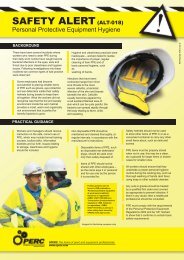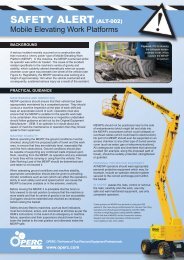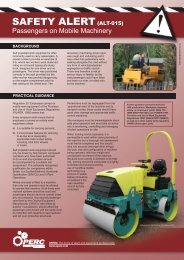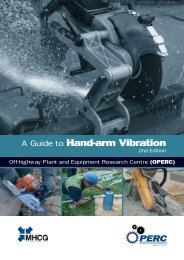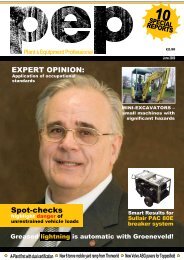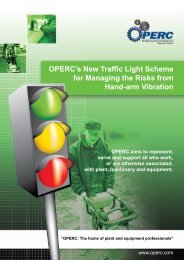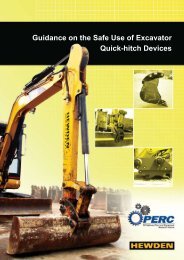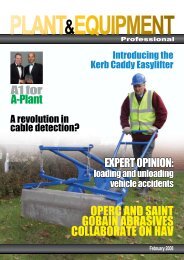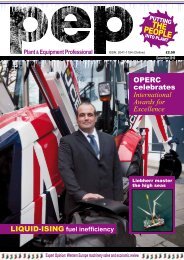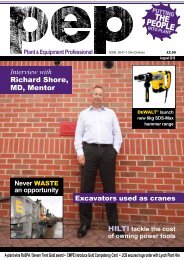expert opinion: - OPERC - Off-highway Plant and Equipment ...
expert opinion: - OPERC - Off-highway Plant and Equipment ...
expert opinion: - OPERC - Off-highway Plant and Equipment ...
You also want an ePaper? Increase the reach of your titles
YUMPU automatically turns print PDFs into web optimized ePapers that Google loves.
early DeVeloPments<br />
The tireless developers at Ammann<br />
soon produced a number of new models<br />
of compaction rollers, characterised<br />
by several technical advantages. The<br />
new compact range was controlled by<br />
an operator sitting on top of the roller;<br />
its responsive steering - even though<br />
mechanical in nature - left hardly any<br />
offset tracks, whilst its drive was virtually<br />
jolt-free <strong>and</strong> guaranteed a presentable,<br />
smooth surface.<br />
However, in America at the end of the<br />
1920s, the occurrence of two dam bursts<br />
(with grave consequences) triggered a<br />
development in compaction technology<br />
that marked an epochal turning point.<br />
California’s water authorities defined<br />
the measurement method developed<br />
by American engineer Ralph Proctor -<br />
named the ‘Proctor test’ in his memory<br />
- as the minimum target requirement<br />
for adequate substrate compaction.<br />
Proctor’s work demonstrated in particular<br />
that the moisture content of a substrate<br />
is of crucial importance to the maximum<br />
possible degree of compaction.<br />
Pertinent to the development of<br />
compaction equipment is that the<br />
degree of compaction defined by the<br />
Proctor Value could not be achieved<br />
with the conventional method of static<br />
compaction. This therefore led to the first<br />
attempts to equip rollers with eccentrics,<br />
causing the roller to vibrate, with models<br />
being developed at Ammann during the<br />
second half of the 1930s.<br />
the neW era: ViBratory rollers<br />
Following the Second World War<br />
this new ‘vibratory’ method of<br />
compaction gave rise to fascinating<br />
technologies that in turn led to<br />
seminal improvements in the<br />
possibilities <strong>and</strong> quality of road<br />
construction. From this point the<br />
subsidence process of fresh earth<br />
in the substructure of the road was<br />
reduced to a minimum.<br />
The first towed vibratory rollers<br />
achieved compaction results that<br />
were previously unknown. The<br />
weight of the vibratory rollers no<br />
longer played such a significant<br />
role as it did in the preceding static<br />
models; three to four times the level<br />
of compaction was now achievable<br />
with the same weight.<br />
Once again, Ammann’s<br />
development engineers saw an<br />
opportunity to achieve more efficient<br />
compaction results on earth <strong>and</strong><br />
asphalt substrates with compact<br />
machines of a two tonne weight<br />
category, a development welcomed<br />
by site engineers.<br />
The successful DTV (double t<strong>and</strong>em<br />
vibration) range was developed at<br />
the end of the 1960s, first in the<br />
form of a vibrating drum followed<br />
just a few years later by double<br />
vibration, offering the operator<br />
a broad spectrum of possible<br />
uses. <strong>Off</strong>set drums prevented the<br />
SPECIAL REPoRT<br />
creation of tracks during asphalt<br />
compaction, whilst an articulated<br />
joint capable of oscillating by up<br />
to 8° – the object of an Ammann<br />
patent – followed twists in the<br />
surface without causing cracks<br />
<strong>and</strong> the side clearance enabled<br />
compaction right up against<br />
the wall. These ‘self-driving’<br />
machines enabled the operator<br />
to concentrate fully on the job in<br />
h<strong>and</strong> without tiring.<br />
Walk-behind vibratory rollers were<br />
developed in Hennef during the<br />
mid-1960s <strong>and</strong> found a market<br />
niche in the 500 to 800 kg range;<br />
the rapid development of urban<br />
road networks <strong>and</strong> a variety of<br />
uses soon made any building<br />
site virtually unthinkable without<br />
them. Nonetheless, there was<br />
still room for further development<br />
in the category of light-weight<br />
mini-compactors. Unidirectional<br />
<strong>and</strong> reversible vibratory plates<br />
equipped with powerful petrol or<br />
diesel engines met a dem<strong>and</strong> that<br />
is still growing today.<br />
A trading partnership for<br />
walk-behind rollers founded<br />
in the 1970s culminated in<br />
the acquisition of the German<br />
company <strong>and</strong>, as a result, an<br />
expedient addition to the model<br />
range that secured a number of<br />
valuable patents for Ammann.<br />
Ammann three-wheeled motor roller with steering device, circa 1935 Ammann vibratory t<strong>and</strong>em roller with steering drum, 1967<br />
June 2011<br />
25



